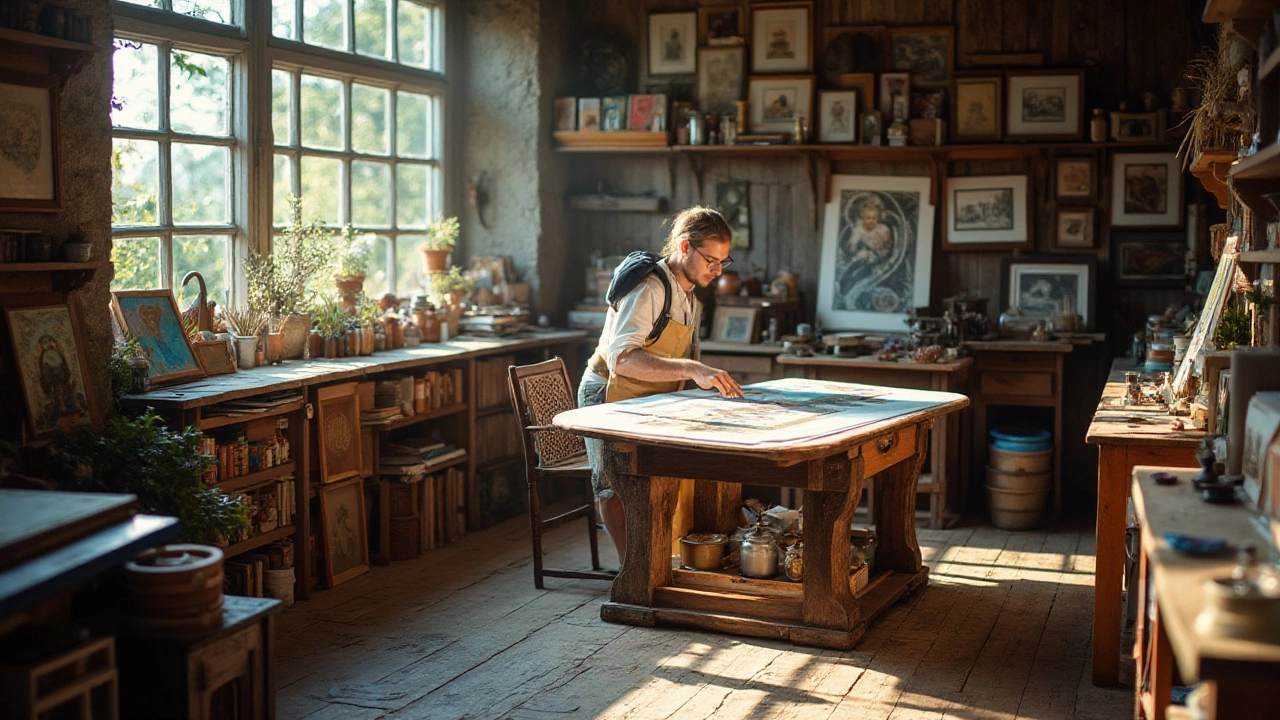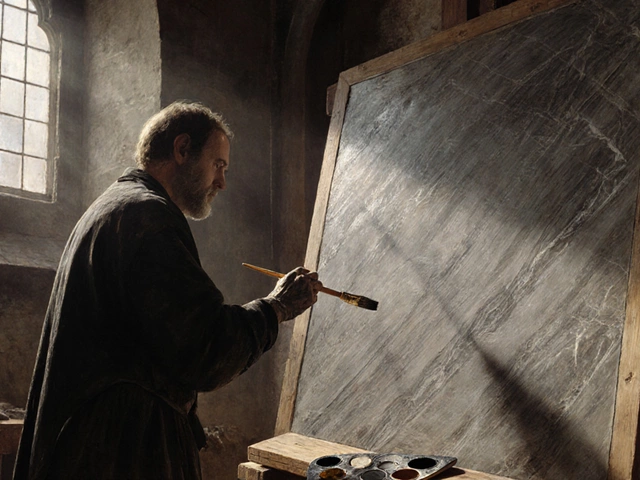In the ever-evolving world of art, understanding the nuances between different types of prints can be both fascinating and essential, especially for collectors and enthusiasts alike. Art prints and regular prints are distinct entities, each with unique characteristics and purposes. To truly appreciate and discern their values, it's important to delve into what makes them stand apart.
This exploration will help illuminate the individual beauty and significance of each print type, from the meticulous processes involved in art prints to the versatility and widespread accessibility of regular prints. Whether you're looking to adorn your home with a splash of culture or invest in art for the future, knowing these differences is crucial in making informed choices.
- Defining Art Prints and Regular Prints
- Production Methods and Materials
- Artistic Value and Perception
- Collectibility and Market Value
- Tips for Choosing Between Art and Regular Prints
Defining Art Prints and Regular Prints
When we talk about prints, it’s essential to delineate the boundary between art prints and regular prints, as they serve different purposes and cater to diverse audiences. Art prints are often considered reproduction prints made using high-quality inks and papers, capturing the authenticity and nuances of an original artwork. These are not mere copies; art prints carry the essence and intent of the original piece, and artists often limit the number of prints, creating collectible editions. The rarity can add significant art and cultural value. In contrast, regular prints are mass-produced versions that prioritize accessibility over exclusivity. Often, these prints are produced in large volumes using commercial printers, and the main aim is widespread dissemination rather than the intimate, personal touch offered by limited art prints.
It's interesting to note that the production process itself can significantly influence the characteristics of each print type. Art prints frequently employ techniques such as giclée printing, which uses specialized inkjet printers to deliver vivid color and sharp details, ensuring that every brushstroke or pencil line of the original artwork is faithfully replicated. The quality and thickness of the materials, like acid-free papers or canvas used, also play a vital role in sustaining longevity and visual fidelity. Conversely, regular prints are typically created using processes like lithography or digital printing on standard paper, sacrificing some of the intricate details and color depth appreciated in art prints for affordability.
The difference is not only technical but visual and emotional, as art prints often carry unique elements like artist signatures, numbering, or even distinctive watermarks, enhancing their uniqueness. Regular prints, while visually appealing, are less likely to boast these personalized touches. Art aficionados often describe their experiences with art prints as engaging in a conversation with the artist, experiencing a part of the artist’s world. This sentiment is echoed in art circles. “Every painting is a voyage into a sacred harbour,” remarked the renowned American artist Giotto di Bondone, tying the mystical connection between creator and admirer embodied through these prints.
The choice between acquiring an art print versus a regular print often boils down to an individual's personal preference, financial capacity, and the intended purpose of the artwork. While regular prints offer an easy solution for decorating residential or commercial spaces without breaking the bank, art prints can serve as a more strategic purchase for serious collectors. In fact, statistics show that the art print market has witnessed a steady year-over-year growth, as more people recognize the value in these tangible connections to artistic talent. An understanding of these key distinctions can help art enthusiasts make informed decisions, cultivating both appreciation and knowledge in the process.
Production Methods and Materials
The creation process of art prints and regular prints involves distinctly different techniques and materials that contribute significantly to their authenticity and appeal. Art prints are often the product of a more hands-on approach, where artists and printmakers use traditional printmaking techniques such as etching, screen-printing, or lithography. These methods allow for unique textures and elements that can be felt and seen, providing each print with an individuality that machine-made replicas simply lack. The use of high-quality materials such as archival inks, fine art paper, and sometimes even canvas ensures that these prints retain their vibrancy and structural integrity for years, if not decades. This meticulous attention to detail often means that real art prints are produced in limited editions, which can increase their value over time.
In contrast, regular prints are typically mass-produced using digital printing technology. This method employs state-of-the-art printers that can produce thousands of copies quickly and with consistently high quality. Printers use digital files to reproduce artworks, often resulting in flat, uniform pieces that may not have the depth and richness achieved through traditional methods. The materials used here, like standard inks and commercial-grade paper, are generally more economical. Despite their pristine surface and accessibility, these prints tend to lack the longevity and investment potential of art prints. However, they are perfect for those who seek accessible options for home or office décor, enjoying a place of significance in the mass market due to their affordability and variety.
"The art of printmaking is one of crafting artworks that hold value not just in their visual representation but in the method of their creation," noted a leading art critic in the New York Art Review.
When considering art prints versus regular prints, it's essential to recognize that these distinctions stem from artistic intent and craftsmanship. The selection of materials and techniques is closely tied to the envisioned purpose of the artwork, whether to create one-of-a-kind masterpieces or to supply art to the masses. As technology advances, the lines may blur somewhat, but the distinctive charm of traditionally produced art prints remains unrivaled. Enthusiasts often seek out the tactile and tangible qualities inherent in art prints, qualities that celebrate the artist’s original work in a way that resonates with the art's soul and spirit.
As the digital landscape grows, the production of regular prints has become an efficient means for artists to reach wider audiences without sacrificing a connection to the audience. Through the digital realms of online marketplaces and social media, art in this form travels far beyond the conventional gallery walls, democratizing access to beautiful visual art. Whether one is affectionately drawn to art prints or sees the value in regular prints, understanding the distinct methods and materials involved can guide choices and foster a deeper appreciation for the art itself.

Artistic Value and Perception
Art prints and regular prints represent more than a simple divergence in production techniques; they embody distinct perspectives on art's value and how it is perceived by enthusiasts and collectors alike. An art print, often crafted with the artist's engagement or supervision, carries an intrinsic connection to the artist’s original vision and intent. This connection provides art prints with a layer of authenticity and uniqueness, often translating into higher artistic value. These prints might be limited editions, where only a specific number are produced, which often enhances their allure and rarity among collectors. Artists might even hand-sign these prints, which adds another personal touch that can significantly impact their perception and worth.
Regular prints, while they have their own charm, usually prioritize accessibility and affordability. They are mass-produced, making art more approachable to the general public. Yet, in doing so, they may lack the personal touch and exclusivity found in art prints. Despite this, regular prints play a crucial role in democratizing access to art, allowing many to enjoy beautiful works without the hefty price tag associated with originals or limited editions. This dichotomy between exclusivity and accessibility demonstrates the wide range offered by the art world, catering to different tastes, budgets, and purposes. As a result, the market value and personal worth of each type also vary accordingly.
The perception of a print's value is not solely defined by its creation process; it also hinges on cultural and individual factors. For some, possessing an art print that echoes the essence of the original work, even in a recreated form, provides a profound sense of connection and ownership. For others, the joy might lie in the beauty presented by a regular print, which captures the essence of the artwork without the unique features of an art print. A quote attributed to Ansel Adams highlights this appreciation:
"You don’t make a photograph just with a camera. You bring to the act of photography all the pictures you have seen, the books you have read, the music you have heard, and the people you have loved."This hints at the emotional, historical, and personal dimensions that influence how we value various forms of art.
Interestingly, even the same piece of artwork can evoke different perceptions depending on whether it's an art print or a regular print. While an art print might be seen as a closer approximation to the original, appealing to purists and collectors, regular prints often find their place in homes, offices, or public spaces, appreciated as decor or conversation starters. This variance in context and usage underscores the multiple dimensions and layers of art as an experience, beyond just an object to own. Hence, when considering artistic value and perception, it's crucial to understand these prints as representing different consumer needs, market niches, and cultural aesthetics.
Collectibility and Market Value
When diving into the realm of art and regular prints, their collectibility and market value often come into focus, shaping both the art market and the decisions of potential buyers. Art prints, particularly limited editions, hold significant value for collectors. They are usually produced in restricted numbers, which inherently increases their scarcity. This rarity can make them more desirable, driving up market value. For instance, an art print by a renowned artist like Banksy sold for tens of thousands of dollars at auction, purely because it was a limited edition. Such pieces are often signed by the artist or marked with a unique identifier, enhancing their authenticity and allure among collectors.
Regular prints, on the other hand, tend to be mass-produced, which naturally impacts their market standing differently. These prints can be reproduced in large quantities, making them more accessible but less valuable from an investment perspective. However, this high availability makes them a popular option for those looking to enjoy art without breaking the bank. Their affordability allows wider access to art, bringing beauty into daily life without the hefty price tag associated with limited edition art prints.
The market value of art prints is not only influenced by their quantity but also by the artist's reputation and the print's condition. The status of the artist can significantly elevate a print's worth; if the artist’s original works are sought after, even their prints can command substantial sums. Additionally, the physical condition of the art print plays a crucial role—it must be well-preserved, keeping its vibrancy and structural integrity to maintain or increase its value over time.
In contrast, the market perception of regular prints often hinges more on their decorative appeal than collectibility. While not typically purchased with investment in mind, regular prints serve a vital role in the market by providing art at an affordable price, allowing people to enjoy a bit of culture and design in their homes. A fun fact to note is that the affordability of regular prints can make them an excellent vehicle for emerging artists to reach a broader audience, helping them gain recognition in the art world.
When considering factors that influence the collectibility and market value of prints, it is essential to look at both subjective appreciation and tangible market trends. Art prints often come with narratives—whether it's the story of the artist or the cultural and historical context of the piece. These stories can add layers of value not easily quantified but definitely felt. Without a doubt, understanding these different dimensions can lead to more informed decisions when purchasing art or looking to appreciate its future value. In the words of art critic and historian Robert Hughes,
"Art should be something that liberates your soul, provokes the imagination and encourages people to go further."This liberation and provocation are intricately tied to the inherent value that both art and regular prints offer their audiences.

Tips for Choosing Between Art and Regular Prints
Navigating the world of prints can be daunting, especially when trying to choose between art prints and regular prints. Each type serves diverse purposes and attracts a different audience, which is why understanding your own needs and expectations is key. Whether it's for investment, decoration, or personal enjoyment, the decision hinges on multiple factors, such as budget, aesthetic preference, and the intended use of the prints. Start by examining the quality of the print – art prints often involve techniques that enhance texture, depth, and vibrancy, made possible by fine art papers or canvas, and inks that are designed to last. On the other hand, regular prints are typically produced en masse and utilize commercial-grade materials, which, while cost-effective, may not have the same durability or color fidelity.
One significant consideration is the print's long-term value. If the purpose is to build a collection or invest, then the uniqueness and potential for appreciation make art prints more attractive. Art prints are often released in limited editions, a feature that can increase their value over time as they become scarce. Regular prints, due to their mass-production nature, do not share this characteristic. This could affect their desirability and resale potential in the future. Additionally, the emotional and aesthetic impact should be weighed. Art prints tend to offer a richer, more nuanced representation of the artist's original vision, thanks to advanced processes like lithography or giclée printing used by many talented artisans.
As famously noted by art critic John Berger, "The essence of a painting travels along with the artwork, remaining in the print as long as it retains the artist's touch." This suggests that the quality and authenticity of art prints can provide a more profound connection to the art itself.
Cost is another practical aspect to think about. Budget constraints play a vital role in determining which print type to purchase. Regular prints are universally cheaper, providing an easy avenue for art adorers to carry visual expressions into their homes without the hefty price tag. For those new to collecting or decorating on a tight budget, regular prints may represent the perfect introduction to home artistry. When planning a purchase, it might be beneficial to consider venue options where you might find discounts or offers on both art and regular prints.
Lastly, recognize the context in which you plan to display your print. For formal settings or spaces that necessitate a touch of elegance and sophistication, an art print's superior quality and prestigious appeal can frame the ambiance with grace and class. Conversely, regular prints serve well in casual environments and are ideal for mood enhancement or thematic decoration as they can easily be changed or replaced without significant cost implications.
| Aspect | Art Prints | Regular Prints |
|---|---|---|
| Material Quality | High | Moderate |
| Print Longevity | Long-lasting | Shorter lifespan |
| Cost | Higher | Low |
| Limited Editions | Yes | No |





